The best thing about kayaking is its versatility as an adventure sport. With the right types of kayaks, you can venture alongside dramatic ocean coastline, paddle for miles on picturesque canals, spend a day on a tranquil lake, or tackle white water rapids. Some kayaks are built for speed, while others are designed for stability, manoeuvrability, for playing in the ocean surf, or for covering long distances. Some are made to sit inside while others are made to sit on top. Some fold to a convenient travel size while others are inflatable. You don’t have to paddle alone either because you can opt for a tandem kayak or a family-sized kayak.
With so many options, it’s no wonder that picking the right kayak for you feels like a challenge. If you’re buying your first kayak, or you’re looking to upgrade, there are lots of factors to consider. To help you make the right choice, we’ve put together a guide to the different types of kayaks on the market today, including the best use for each type of kayak and their pros and cons.
If you’re unsure if a kayak is even the right type of floating vessel for you, then you may want to do a bit more reading. Here are some resources that should help:
- The similarities and differences of canoes and kayaks (plus the pros and cons of each)
- The different types of canoes
- The similarities and differences of kayaks and paddle boards (plus the pros and cons of each)
- Portable kayaks
Types of kayaks
Now that we’ve got that cleared up, here’s a list of all the different kayak options out there.
- Types of flatwater kayaks
- Sea kayaks
- Types of whitewater kayaks
- Other types of kayaks
- Types of specialist kayaks
- Choosing the right type of kayak for you
Disclaimer: We use affiliate links and may receive a small commission on purchases.
Types of flatwater kayaks
Flatwater kayaks are for calm waters such as small to medium-sized lakes, ponds, marshlands, gentle rivers, canals, and sheltered ocean inlets.
Types of flatwater kayaks include:
Recreational kayaks
Recreational kayaks are the best types of kayaks for beginners. They typically feature large and comfortable cockpits and wide rounded hulls that are stable and easy to turn. Recreational kayaks don’t track well and are easily blown off course. That’s why they are best for paddling short distances on sheltered waters.
Recreational kayaks are usually between eight and twelve feet in length and some have storage hatches. With a recreational kayak, you can choose between a sit-in or a sit on top kayak.

Sit-in recreational kayaks
BEST FOR: beginners and experienced paddlers, cold water paddling or cold weather
 Sit-in kayaks are the most common type of kayak and preferred by most paddlers. With a sit-in kayak, your legs are enclosed in the hull of the boat. Your toes rest against foot pegs and your knees are braced against the sides of the boat. This sitting position gives you more control and allows you to gain more speed as you lean into each paddle stroke. Most come with a built-in seat, and the best sit-in kayaks have adjustable backrests.
Sit-in kayaks are the most common type of kayak and preferred by most paddlers. With a sit-in kayak, your legs are enclosed in the hull of the boat. Your toes rest against foot pegs and your knees are braced against the sides of the boat. This sitting position gives you more control and allows you to gain more speed as you lean into each paddle stroke. Most come with a built-in seat, and the best sit-in kayaks have adjustable backrests.
The cockpit is closed with a water-resistant spray deck which keeps the water out. If you get into a sit-in kayak from a pontoon or riverside, there’s a good chance that your lower body will stay dry the entire time you’re out on the water. That makes a massive difference on cold and rainy trips. However, sit-in kayaks tend to be less stable and if you capsize (and don’t know how to roll), then you’ll either need a paddle buddy to help you get back in the boat (deep sea rescue), or you’ll need to drag the boat to the nearest patch of land.
Pros
- You stay dryer and warmer
- Better control
- Can travel faster (compared to a sit on top kayak)
- Often comes a watertight storage hatch
Cons
- Less stable
- Tricky to recover from a capsize
- Smooth entrance/exit takes a bit of practice
Sit on top recreational kayaks
BEST FOR: beginners, warm weather kayaking, easy entrance/exit
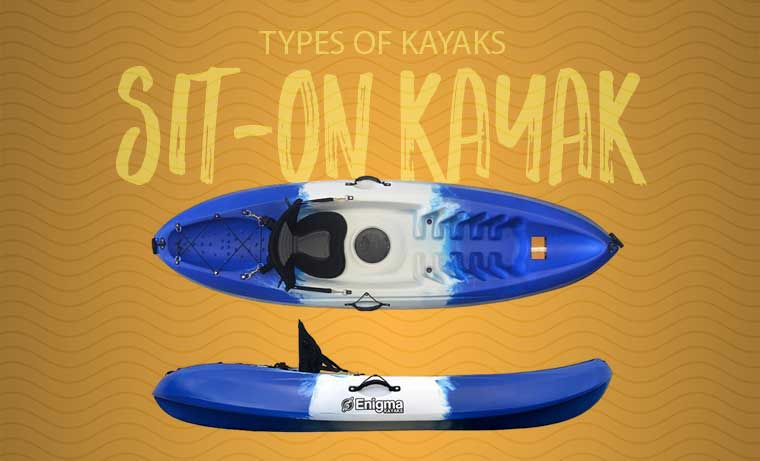 Most sit on top kayaks are wide, stable, and difficult to tip, making them the right choice for beginner paddlers. If you do manage to tip one, you can flip it up the right way, crawl back on and resume paddling. The water will drain through scupper holes in the base of the boat. If you want to jump off for a swim, then a sit on top recreational kayak is a lot more practical than a sit-in kayak. That’s why sit on tops are the type of kayak you’ll typically see available for rent at activities centres and touristic locations.
Most sit on top kayaks are wide, stable, and difficult to tip, making them the right choice for beginner paddlers. If you do manage to tip one, you can flip it up the right way, crawl back on and resume paddling. The water will drain through scupper holes in the base of the boat. If you want to jump off for a swim, then a sit on top recreational kayak is a lot more practical than a sit-in kayak. That’s why sit on tops are the type of kayak you’ll typically see available for rent at activities centres and touristic locations.Sit on top kayaks have a built-in backrest, sometimes adjustable, and footrests. The cockpit is wide and open, offering plenty of space for larger paddlers and long legs. The disadvantage is that you have no protection from wind or rain. Even in good weather, you’ll get wetter than you would in a sit-in kayak.
Pros
- Very stable
- Easy to enter/exit
- Easy to recover from a capsize
- Usually cheaper
Cons
- No weather or spray protection
- Limited control
- You’ll need dry bags and bungees to carry any gear
Day touring kayaks
BEST FOR: short to medium-length trips, beginner/intermediate paddlers
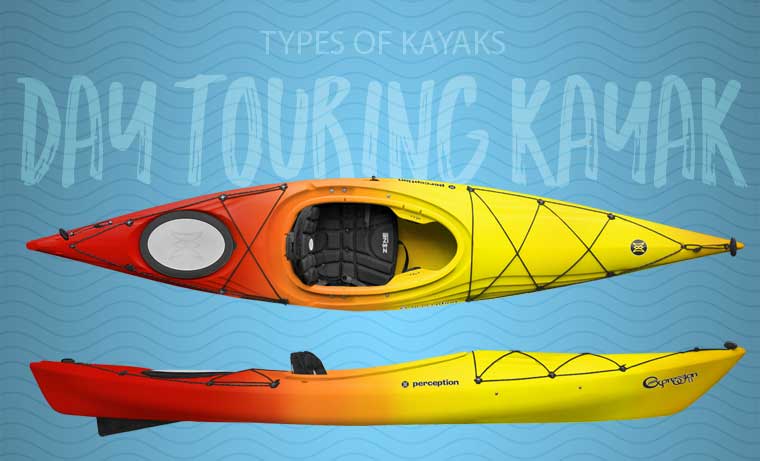 Day touring kayaks are a midway point between a recreational kayak and a full touring kayak. They’re longer and narrower than recreational kayaks and therefore track better, but they still have a relatively wide and stable hull. Some come with a rudder or skeg for better steering.
Day touring kayaks are a midway point between a recreational kayak and a full touring kayak. They’re longer and narrower than recreational kayaks and therefore track better, but they still have a relatively wide and stable hull. Some come with a rudder or skeg for better steering.Like recreational kayaks, day touring kayaks typically feature a comfortable cockpit that’s easy to enter/exit. Because day touring kayaks move more efficiently than recreational kayaks, you can cover longer distances without tiring so quickly. They’re more versatile and able to handle moderately rough waters and light winds. However, this type of kayak is not designed for extended trips.
Pros
- Excellent transition boat for beginner/intermediate paddlers
- Improved tracking
- Easy-to-access cockpit
- Plenty of storage space
Cons
- Not as stable as a recreational kayak
Touring kayaks
BEST FOR: long distances on flat water
 Touring kayaks are long, 12 to 18 feet, and narrow. They track well and often come with a rudder or skeg for improved steering. If you like the idea of paddling the length of a canal or river over multiple days, then this is the best type of kayak for you. The aerodynamic design reduces the physical stress of paddling and allows you to travel faster. Touring kayaks have large storage lockers, usually one in front of the cockpit and one behind, so you can carry gear for multiple days. They come with wider cockpits than sea kayaks, for comfortable all-day paddling, but narrower cockpits than recreational kayaks.
Touring kayaks are long, 12 to 18 feet, and narrow. They track well and often come with a rudder or skeg for improved steering. If you like the idea of paddling the length of a canal or river over multiple days, then this is the best type of kayak for you. The aerodynamic design reduces the physical stress of paddling and allows you to travel faster. Touring kayaks have large storage lockers, usually one in front of the cockpit and one behind, so you can carry gear for multiple days. They come with wider cockpits than sea kayaks, for comfortable all-day paddling, but narrower cockpits than recreational kayaks.Some cockpits on touring kayaks are also shorter and more challenging to enter/exit. If your usual kayaking routes involve portage (carrying the boat around low bridges or locks), then you’ll want to think twice about using a touring kayak with a tight cockpit.
Pros
- Tracks well over longer distances
- Plenty of storage
- More stable than sea kayaks
Cons
- Struggles with tight bends
Sea kayaks
BEST FOR: ocean, choppy water, distance paddling
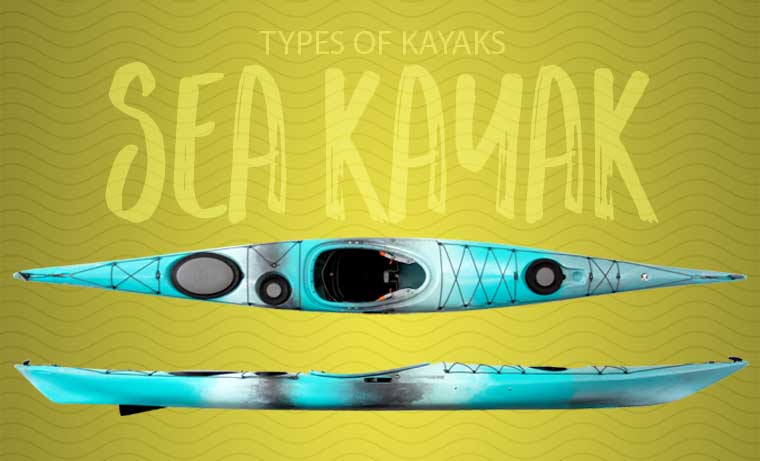 As the name suggests, sea kayaks perform best on ocean waters. At first glance, sea kayaks are similar to touring kayaks, but they are slightly longer and narrower. The main differences are in the hull, which is v-shaped rather than rounded, and the bow and stern which are more sharply pointed. The aerodynamic shape allows you to maintain faster speeds with ease. The pointed nose, coupled with a high rocker, is designed to break through waves. Meanwhile, the v-shaped hull sits lower in the water than flatwater kayaks making it more stable in rough waters and able to track straight in strong winds.
As the name suggests, sea kayaks perform best on ocean waters. At first glance, sea kayaks are similar to touring kayaks, but they are slightly longer and narrower. The main differences are in the hull, which is v-shaped rather than rounded, and the bow and stern which are more sharply pointed. The aerodynamic shape allows you to maintain faster speeds with ease. The pointed nose, coupled with a high rocker, is designed to break through waves. Meanwhile, the v-shaped hull sits lower in the water than flatwater kayaks making it more stable in rough waters and able to track straight in strong winds.Although sea kayaks are designed for open waters, they also perform well on flat water, but they are trickier to manoeuvre than other types of kayaks. Also, sea kayaks often have a smaller cockpit which offers better weather protection but makes it difficult to get in and out.
Additional features of sea kayaks include generous storage hatches, sufficient for a multi-day trip. Some types of sea kayaks have a rudder or skeg for better tracking. More expensive models may also have a small bilge pump for bailing out water.
Pros
- Tracks well on rough waters
- Narrow design lets you travel faster
- Plenty of storage space
- Less susceptible to winds
Cons
- Less stable hull shape
- Tricky to manoeuvre
- Tend to be more expensive
Types of whitewater kayaks
Whitewater kayaks are short, wide, and some will turn a full 360 degrees with a single side stroke. Exactly what you need when you have rocks and boulders blocking your path. Whitewater kayaks are also easier to roll than other types of kayaks. Hard shell whitewater kayaks are always sit-in, and most are made from durable remoulded plastic.
There are four main types of whitewater kayaks which range from approximately 4 foot to 10 foot in length. The shorter the kayak, the quicker it will turn but the trickier it will be to keep in a straight line.
Types of whitewater kayaks include:
Playboats
BEST FOR: freestyling, playing in holes, weirs, and surfing
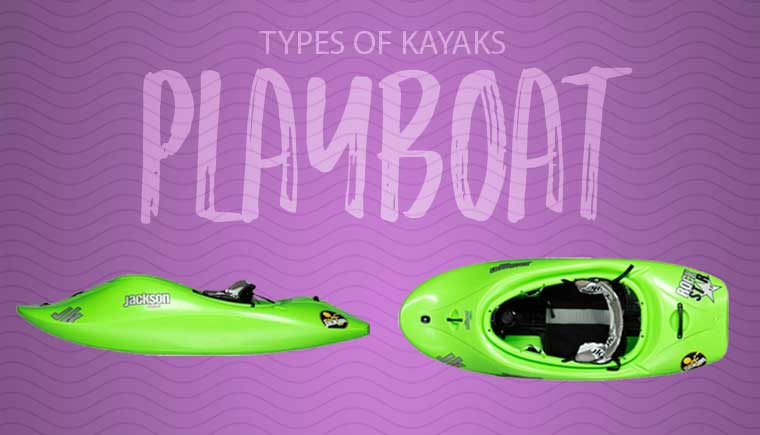 These are the shortest whitewater kayaks, typically four to eight feet in length. Playboats are designed for playing in a single spot, surfing waves, holes, and freestyle tricks, not for A to B routes. These boats have a low volume bow and stern, a stable cockpit, and a flat hull that allows it to turn on a central point. Controlling a playboat is a full body workout, and these types of kayaks are best for experienced whitewater kayakers.
These are the shortest whitewater kayaks, typically four to eight feet in length. Playboats are designed for playing in a single spot, surfing waves, holes, and freestyle tricks, not for A to B routes. These boats have a low volume bow and stern, a stable cockpit, and a flat hull that allows it to turn on a central point. Controlling a playboat is a full body workout, and these types of kayaks are best for experienced whitewater kayakers.Pros
- Turns on its centre
- Well balanced for vertical tricks
- More portable than larger kayaks
Cons
- Not suitable for downriver paddling
- Difficult to control
Creekboats
BEST FOR: longer downriver trips on rivers with rapids
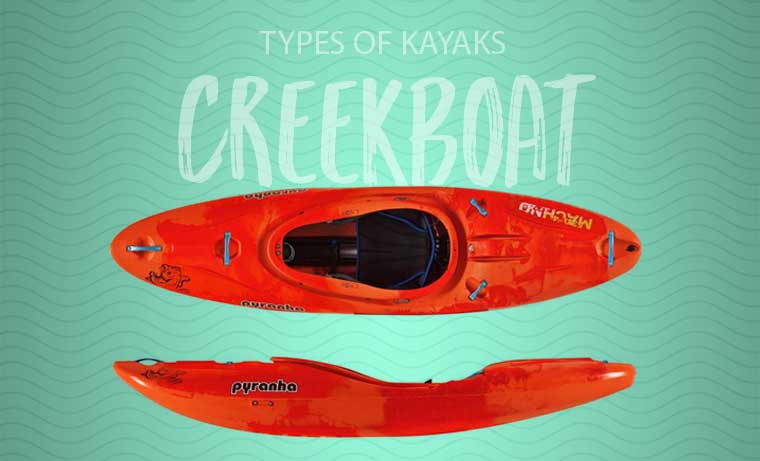 On the opposite end of the scale are creekboats. These are longer, have a high volume, and are equally weighted around the cockpit (unless you choose a creekboat with a displaced hull). This type of whitewater kayak is difficult to submerge and designed to resurface quickly. Most also feature dual edging on the bottom which helps you control the boat when crossing eddies. Creekboats are considered multi-purpose because, at a push, you could use one to navigate a longer route on a flatter river.
On the opposite end of the scale are creekboats. These are longer, have a high volume, and are equally weighted around the cockpit (unless you choose a creekboat with a displaced hull). This type of whitewater kayak is difficult to submerge and designed to resurface quickly. Most also feature dual edging on the bottom which helps you control the boat when crossing eddies. Creekboats are considered multi-purpose because, at a push, you could use one to navigate a longer route on a flatter river.Pros
- Resurfaces quickly
- More stable
- Better tracking and carving
- Multi-purpose
Cons
- Not designed for playing in holes or freestyling
River runners
BEST FOR: downriver rapid trips on rivers with short flat sections
 River runners, or downriver kayaks, are usually between seven and eight-foot-long, are a compromise between a creekboat and a playboat. They offer just enough tracking to get you across the flat sections of a river but are still manoeuvrable enough for surf and some freestyling.
River runners, or downriver kayaks, are usually between seven and eight-foot-long, are a compromise between a creekboat and a playboat. They offer just enough tracking to get you across the flat sections of a river but are still manoeuvrable enough for surf and some freestyling.Pros
- Better tracking than playboats
- Turns on its centre
- Comfortable cockpit
- May have space to store gear
Cons
- Not suitable for use on flat rivers or longer trips
Duckies (inflatable whitewater kayaks)
BEST FOR: downriver trips on moderate rapids
 Although they don’t turn as efficiently, duckies are a practical alternative to hard shell whitewater kayaks. They’re more compact and therefore more portable. Once deflated, you can put one in the boot of the car instead of installing a roof rack. Additionally, you don’t need a ton of space at home to store them.
Although they don’t turn as efficiently, duckies are a practical alternative to hard shell whitewater kayaks. They’re more compact and therefore more portable. Once deflated, you can put one in the boot of the car instead of installing a roof rack. Additionally, you don’t need a ton of space at home to store them.Duckies are wide, stable, and made from durable materials. Because you sit on top of inflatable whitewater kayaks, they’re also more comfortable on downriver trips or for larger paddlers.
Pros
- More portable
- Light enough to be carried short distances
- Can carry some gear (if attached securely)
Cons
- Not as good as hard shells on sharp turns
- Paddlers will get wetter
Other types of kayaks
The above list of kayaks are all designed for specific conditions and are best suited to different levels of kayaking. However, there are a couple more types of kayaks that you also need to consider that are designed more around lifestyle and convenience. They also sit within one or more of the above kayak types. These include:
Tandem kayaks
BEST FOR: any water (depending on the type of kayak)
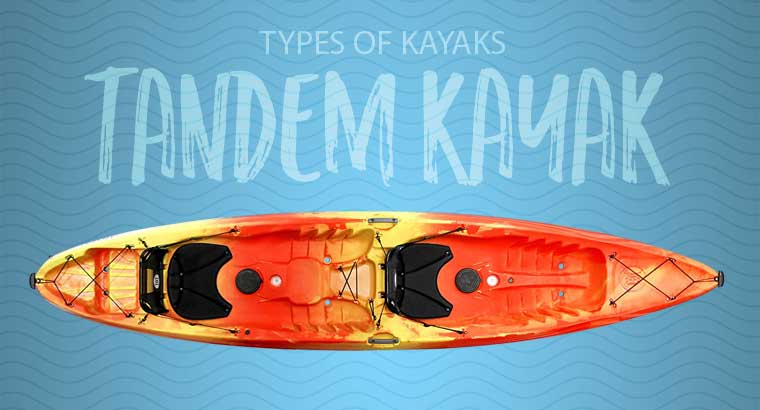 Almost all types of kayaks are available as a tandem kayak, and sometimes as a triple kayak, so you can go paddling with a friend, spouse, or family member. Tandems are an excellent option if you’re taking a child or a less experienced paddler out on the water, but they’re also convenient if you don’t have space to store two boats. Just bear in mind that sit-in tandem kayaks are too awkward to paddle solo.
Almost all types of kayaks are available as a tandem kayak, and sometimes as a triple kayak, so you can go paddling with a friend, spouse, or family member. Tandems are an excellent option if you’re taking a child or a less experienced paddler out on the water, but they’re also convenient if you don’t have space to store two boats. Just bear in mind that sit-in tandem kayaks are too awkward to paddle solo.Modern sit on top tandem kayaks offer more versatility. Most have a 2-in-1 system that allows a seat to be positioned in the centre. That said, tandems are always longer, heavier, and often wider than their solo equivalent, which can make them less portable without the help of a paddling buddy.
Pros
- Perfect for adults with young children
- Great for training new paddlers
- Often more stable
- Some can be converted to solo kayaks
Cons
- Heavier than solo kayaks
Inflatable kayaks
BEST FOR: calm waters, recreational trips
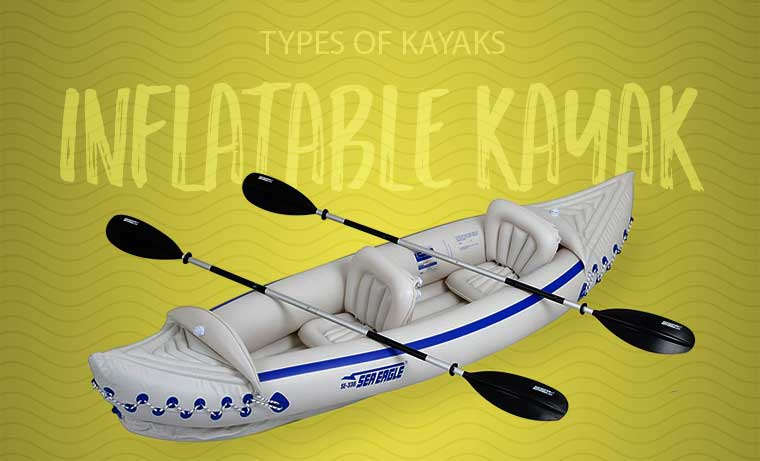 Inflatable kayaks are a convenient alternative if you don’t have space to store or transport a full-sized kayak. Most are designed for two or three paddlers, although single versions are also available. Inflatable kayaks perform best on flat water on days with little wind. They’re not as durable as hard shells but should hold up to the usual bumps and scrapes.
Inflatable kayaks are a convenient alternative if you don’t have space to store or transport a full-sized kayak. Most are designed for two or three paddlers, although single versions are also available. Inflatable kayaks perform best on flat water on days with little wind. They’re not as durable as hard shells but should hold up to the usual bumps and scrapes.Inflatable kayaks are wide, stable, and allow a decent amount of gear storage. Most are partway between a sit on top recreational kayak and a canoe, but some manufactures now make sit-in inflatable kayaks.
Inflatable kayaks are popular among beginners and occasional kayakers because they’re more portable and easier to store than hard shell kayaks.
Pros
- Very portable
- Cheaper than hard shell kayaks
- Easy to paddle on flat water
Cons
- Don’t track as effectively as hard shell kayaks
- Less durable
Folding kayaks
BEST FOR: flatwater paddling
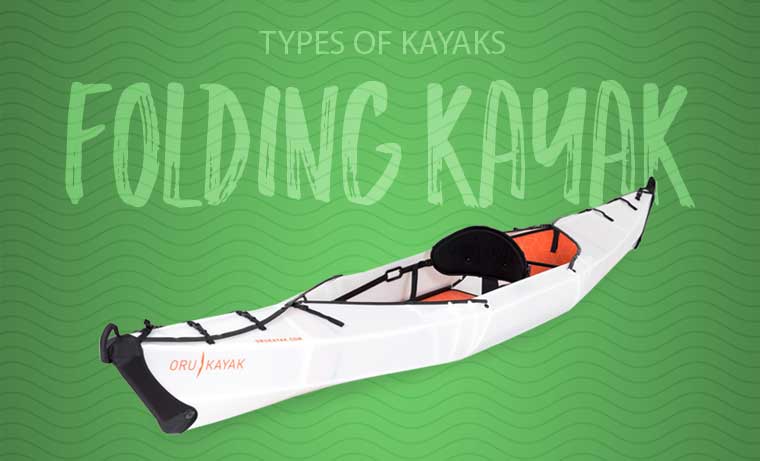 Folding kayaks are another convenient alternative for anyone with limited storage or without a roof rack. These types of kayaks typically separate into two or three pieces and fold down to the size of a large backpack. Because folding kayaks fold flat, there are no storage hatches, and their ‘snap together’ design makes them impractical for rough waters. Like inflatable kayaks, folding kayaks are halfway between a sit on top kayak and a canoe but you paddle with a double-sided paddle.
Folding kayaks are another convenient alternative for anyone with limited storage or without a roof rack. These types of kayaks typically separate into two or three pieces and fold down to the size of a large backpack. Because folding kayaks fold flat, there are no storage hatches, and their ‘snap together’ design makes them impractical for rough waters. Like inflatable kayaks, folding kayaks are halfway between a sit on top kayak and a canoe but you paddle with a double-sided paddle.Pros
- Compact storage
- More portable
- Not as durable as a hard shell
Cons
- Stronger versions are often heavier than hard-shell kayaks
Types of specialist kayaks
Specialist kayaks are made for a very specific type of water, sport, or racecourse. The advantage of any specialised kayak is that it’s made for a purpose. The disadvantage is that specialist kayaks are not very versatile and you’ll probably want to purchase another type of kayak for general use.
Some types of specialist kayaks to be aware of:
Wave-ski kayaks
BEST FOR: playing in ocean surf
 A wave-ski kayak is a cross between a sit on top kayak and a surfboard. This specialist kayak is made for playing in big and small waves. Wave-skis have a flat hull that’s usually less than 10 feet long. They’re made for riding on waves and have either a skeg or fins that improve tracking. Traditionally wave-skis are fitted with a quick-release seat belt and foot straps that keep you anchored to the boat while practising tricks. Instead of a seatbelt, some have knee straps that help you to roll the kayak. Technically, wave-skis can be paddled on flat water, but that would only be comfortable on short distances.
A wave-ski kayak is a cross between a sit on top kayak and a surfboard. This specialist kayak is made for playing in big and small waves. Wave-skis have a flat hull that’s usually less than 10 feet long. They’re made for riding on waves and have either a skeg or fins that improve tracking. Traditionally wave-skis are fitted with a quick-release seat belt and foot straps that keep you anchored to the boat while practising tricks. Instead of a seatbelt, some have knee straps that help you to roll the kayak. Technically, wave-skis can be paddled on flat water, but that would only be comfortable on short distances.Key features:
A flat hull that rides waves
- Built with a skeg or fins
- Sit on top style but with waist, feet, or knee straps
Surf-ski kayaks
BEST FOR: fast paddling in ocean surf
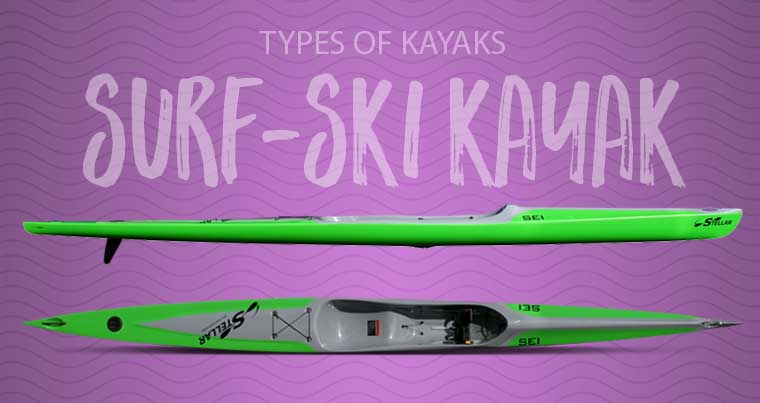 Surf-skis are impressive vessels. They’re long, sometimes over 20 feet in length, low volume, and less than 20 inches wide. They’re the opposite of a wave-ski kayak and yet both types of kayaks are designed for riding waves. The critical difference is that surf-skis are designed to cover distance quickly rather than playing in surf. Modern surf-skis are often made from lightweight materials, such as carbon fibre or Kevlar, and are also known as ocean racers. The surf-skis pointed bow breaks through waves while its aerodynamic shape and v-shaped hull keep you in a straight line. Steering is controlled by foot pedals that operate a rudder so mostly you just need to paddle forwards.
Surf-skis are impressive vessels. They’re long, sometimes over 20 feet in length, low volume, and less than 20 inches wide. They’re the opposite of a wave-ski kayak and yet both types of kayaks are designed for riding waves. The critical difference is that surf-skis are designed to cover distance quickly rather than playing in surf. Modern surf-skis are often made from lightweight materials, such as carbon fibre or Kevlar, and are also known as ocean racers. The surf-skis pointed bow breaks through waves while its aerodynamic shape and v-shaped hull keep you in a straight line. Steering is controlled by foot pedals that operate a rudder so mostly you just need to paddle forwards.Surf-skis are a type of sit on top kayak so expect to get very wet. They are a lot of fun if you live in an area with plenty of surf, but they are very tippy and take some getting used to.
Key features:
Designed for speedy paddling on surf
- Built with a pedal-operated rudder
- Aerodynamic but very tippy
Pedal kayaks
BEST FOR: recreational trips on gentle water, fishing, nature photography
 A step up from family-sized pedal boats, pedal kayaks are set up like a sit on top kayak, but you peddle instead of paddling. They are usually short, stable, and spacious enough for a cooler box and essential gear.
A step up from family-sized pedal boats, pedal kayaks are set up like a sit on top kayak, but you peddle instead of paddling. They are usually short, stable, and spacious enough for a cooler box and essential gear.There are two types of pedal kayaks:
Bicycle style – where your feet move in a forward circular motion to power the propeller, like peddling a bicycle.
Stair climber style – where you push on each foot alternately, like using a stair climber at the gym.
Pedal kayaks are a practical alternative for kayakers with shoulder and back problems as your legs take most of the physical effort rather than your arms. As most people’s leg muscles are stronger than arm muscles, you may be able to cover more distance than you would in a sit on top recreational kayak, however pedal kayaks are much heavier. Another advantage is that your hands are free so you can take photos whilst moving across the water. Most pedal kayaks also come with rudders.
Key features:
Powered by a propeller system instead of a paddle
- Spacious sit on top style
- Some have gear storage
Racing kayaks
BEST FOR: racing on flat or calm waters
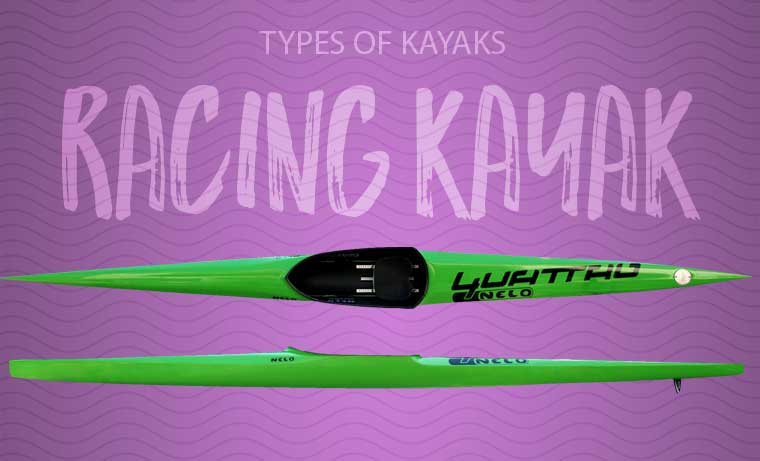 Racing kayaks are long, very narrow, and lightweight. They are mostly used on flat water sprints or for racing downstream. They’re designed for covering distances at speed but also to handle weirs and slightly choppy waters. Racing kayaks sit low in the water, making it difficult for winds to blow them off course. They track very well and always come with rudders that are controlled by the feet and pull up for cruising on shallow waters. Racing kayaks can seat between one and four paddlers.
Racing kayaks are long, very narrow, and lightweight. They are mostly used on flat water sprints or for racing downstream. They’re designed for covering distances at speed but also to handle weirs and slightly choppy waters. Racing kayaks sit low in the water, making it difficult for winds to blow them off course. They track very well and always come with rudders that are controlled by the feet and pull up for cruising on shallow waters. Racing kayaks can seat between one and four paddlers.The hull shape depends on the type of racing kayak. Sprint racing kayaks are designed to move in a straight line as fast as possible; they, therefore, have less curvature between the bow and stern. Sprint racing kayaks are the most slimline but also the least stable. The other primary type of racing kayak is a marathon racing kayak. These are designed for speed over long distances. They have a slightly more stable hull and a higher rocker that can take sharp bends.
Key features:
Aerodynamic shape
- Built with foot controlled removable rudders
- Tracks well
- Available in solo, tandem, triple, or quadruple versions
Slalom racing kayak
BEST FOR: slalom racecourses (whitewater)
 Another variation of the racing kayaks is the slalom kayak. These kayaks are shorter and wider with a pointed nose that breaks through whitewater rapids. They have a flat and wide hull and a high rocker that can turn on a hairpin. Slalom kayaks are designed to tackle tight turns and bumpy rivers at speed. They are not suited to flat water kayaking.
Another variation of the racing kayaks is the slalom kayak. These kayaks are shorter and wider with a pointed nose that breaks through whitewater rapids. They have a flat and wide hull and a high rocker that can turn on a hairpin. Slalom kayaks are designed to tackle tight turns and bumpy rivers at speed. They are not suited to flat water kayaking.Key features:
- Wide and flat hull
- Pointed bow and stern
- Handles tight turns at fast speeds
Choosing the right type of kayak for you
Kayaking is a fun and versatile outdoor sport and there’s no ‘one-size-fits-all’ when it comes to choosing the best type of kayak. What’s important is that you understand what types of kayaks are best for what types of water. After that, you can decide whether you want to enjoy easy recreational paddles at your nearest lake, embark on epic coastal expeditions, play in the surf, or take an adrenaline-filled ride down a whitewater river.
If you’re a beginner, your best bet is a recreational kayak or a day touring kayak.
If you’re at an intermediate or advanced level, then you’ll probably want to invest in a multi-purpose kayak, such as a touring kayak or creekboat, as well as a specialised kayak for your preferred type of excursion.
If you’re still unsure, consider visiting your nearest kayaking centre or a kayaking retailer where you can often experiment with different types of kayaks.
Happy paddling!



